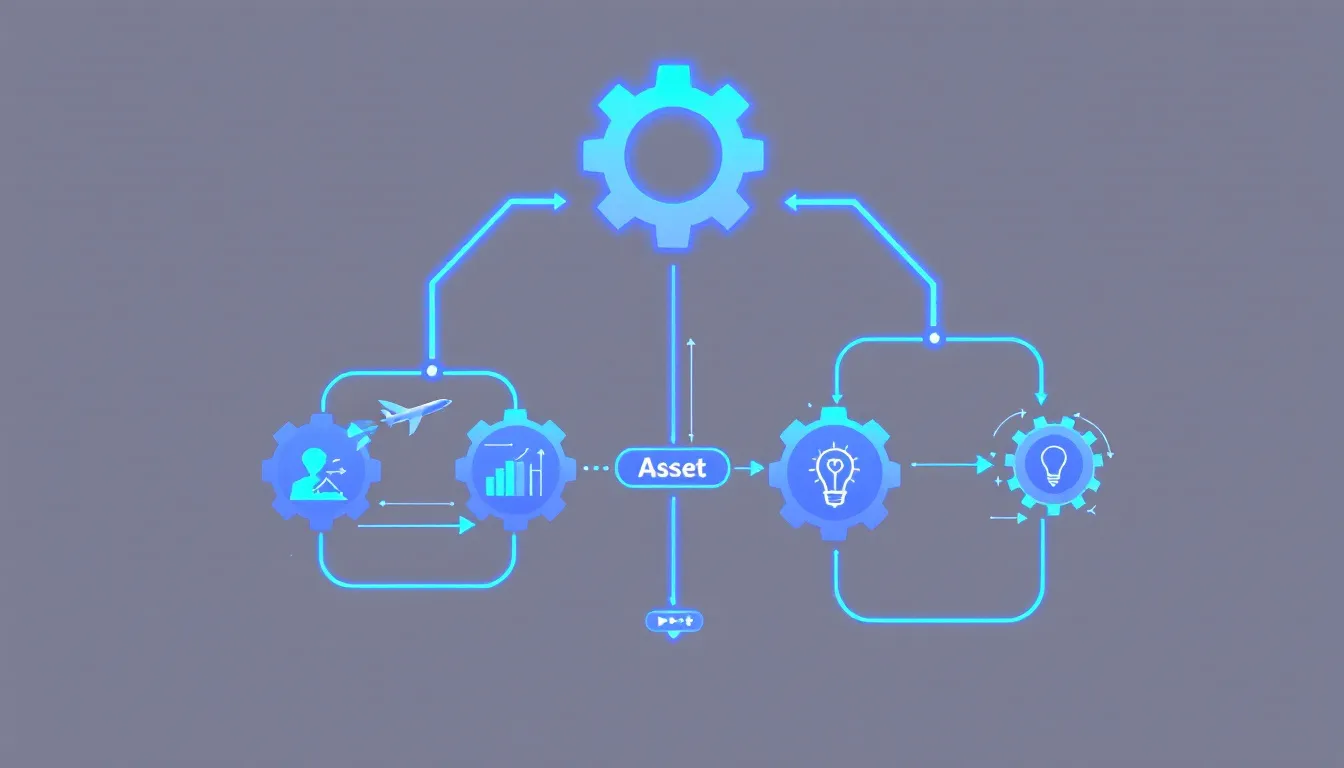Fixed asset management is the strategic handling of a company’s physical assets, from purchase to disposal. It ensures assets are used effectively, well-maintained, and accurately recorded, supporting financial decisions and compliance.
Key Takeaways
- Fixed Asset Management encompasses the entire lifecycle of tangible assets, from acquisition to disposal, ensuring optimal utilization and maintenance for enhanced operational efficiency.
- Accurate asset tracking and valuation are essential for financial reporting, compliance, and informed decision-making, while regular maintenance prevents unexpected failures and extends asset lifespan.
- Implementing advanced technologies, such as automated asset tracking systems and fixed asset management software, streamlines processes improves accuracy, and mitigates common challenges in asset management.
Understanding Fixed Asset Management

Fixed asset management is more than just keeping track of your company’s physical assets; it’s a strategic approach that involves the entire lifecycle of these assets, from acquisition to disposal. This holistic approach ensures that your tangible assets are used optimally, maintained efficiently, and disposed of responsibly. Managing fixed assets is crucial for preventing unexpected losses, optimizing asset utilization, and enhancing overall operational efficiency.
Fixed asset management plays a crucial role in preventing unexpected losses by ensuring all equipment and machinery are well-maintained and functioning correctly. It also supports informed financial decisions by providing accurate asset data for budgeting, financial reporting, and compliance. A holistic approach to asset management integrates and optimizes a company’s physical assets, enhancing operational efficiency and financial transparency.
Next, we explore the definition of fixed assets and the importance of effective fixed asset management for any organization.
Definition of Fixed Assets
Fixed assets, also known as long-term tangible property, are crucial investments that companies use to generate income over several years. These assets include items like machinery, real estate, and office equipment, which are not intended for quick sale but are necessary for ongoing business operations. “Fixed” does not imply immobility; it signifies assets used for long-term operational purposes and not easily converted into cash.
The primary distinction between fixed assets and inventory lies in their usage and purpose. While inventory is meant for short-term sales, fixed assets are long-term investments regularly used in business operations. Examples of fixed assets include land, buildings, and expensive machinery, all of which are critical for the sustained success of a company’s operations.
Grasping the definition and classification of fixed assets is the initial step in managing them effectively.
Importance of Fixed Asset Management
Effective fixed asset management is vital for maintaining financial accuracy, ensuring compliance, and improving operational efficiency. Proper tracking and management of assets help prevent unexpected equipment failures and downtime, maximizing revenue and reducing costs. Accurate asset management also ensures compliance with financial regulations, making financial statements true and accurate representations of a company’s health.
Using advanced tracking technology and fixed asset management systems can significantly enhance operational efficiency. These systems enhance stock control, reduce loss costs, and offer accurate data for budgeting and financial reporting. Understanding asset performance and utilization helps companies make informed financial decisions, ultimately boosting profitability and ensuring long-term success.
Key Components of Fixed Asset Management
Managing fixed assets involves several key components that work together to ensure optimal asset utilization and financial accuracy. From acquisition and depreciation management to asset tracking and disposal, each element plays a crucial role in the overall effectiveness of fixed asset management systems and fixed asset management practices. Creating a comprehensive asset management policy can guide these processes, ensuring consistency and reliability across the organization.
We will detail each component, from asset acquisition to disposal, in the following sections. This structured approach will provide a clear understanding of the various elements involved in managing fixed assets effectively.
Asset Acquisition
The process of acquiring fixed assets involves several methods, including purchasing, constructing, and leasing. Accurate recording of acquisition costs, including taxes and installation fees, is essential for financial reporting and ensuring that the asset’s true value is reflected on the company’s balance sheet. Properly documenting these costs helps maintain financial transparency and aids in future financial planning.
Acquiring fixed assets is just the beginning of their lifecycle, which also includes usage, maintenance, and eventual disposal. Accurately recording all acquisition-related expenses lays the foundation for effective fixed asset management throughout the asset’s useful life.
Depreciation Management
Depreciation management is a critical aspect of fixed asset management, as it involves calculating and recording the reduction in asset value over time. There are various methods for calculating depreciation, each suited to different types of assets. For example, the straight-line method is straightforward and commonly used, while the double-declining balance method is better suited for assets that lose value quickly.
Precise depreciation calculations are vital for financial reporting and tax compliance. Errors in calculating depreciation can lead to significant financial inaccuracies, affecting the true representation of a company’s financial health and influencing tax obligations. Thus, choosing the appropriate depreciation method and ensuring precise calculations are key to maintaining the integrity of financial statements.
Asset Tracking
Asset tracking is fundamental to effective fixed asset management as it helps monitor the location, condition, and usage of assets. Technologies such as barcode systems and RFID are widely used for asset tracking, providing real-time visibility and preventing loss or underutilization. A solid asset tagging system assigns unique identifiers to each asset, simplifying tracking and ensuring data accuracy and currency.
Poor asset tracking practices can lead to incomplete records and significant errors, resulting in misplaced assets and inefficiencies. Reliable asset tracking systems account for all assets, enhancing operational efficiency and financial accuracy.
Asset Valuation
Asset valuation is the process of determining the current worth of fixed assets, which is essential for accurate financial reporting, tax assessments, and insurance coverage. Businesses need to regularly assess the value of their assets. This is important to reflect changes in market conditions, wear and tear, or obsolescence. This ensures that the asset values reflected on the company’s balance sheet are accurate and up-to-date.
Accurate asset valuation impacts various aspects of financial management, including budgeting and compliance with financial regulations. Regular asset valuation allows companies to make informed financial decisions, supporting long-term operational and financial health.
Regulatory Compliance
Regulatory compliance plays a vital role in fixed asset management. It is an essential component that cannot be overlooked. Adhering to standards like GAAP and IFRS ensures accurate financial reporting and minimizes legal risks. Effective software aids organizations in avoiding fines by maintaining audit readiness and regulatory compliance.
Regular audits and synchronization with financial systems further enhance data accuracy and reporting efficiency.
Asset Maintenance
Regular maintenance is crucial for prolonging the lifespan of assets and ensuring their optimal performance. Essential components of asset maintenance include regular inspections, repairs, and preventive maintenance. Failing to service equipment can void warranties and impact both financial and operational viability.
Fixed asset management solutions automate maintenance scheduling, sending reminders to ensure tasks are not overlooked. This proactive maintenance approach reduces unexpected failures, minimizes repair costs, and extends asset lifespans.
Fixed Asset Register
A fixed asset register acts as a centralized database containing key details of each asset, such as acquisition date, cost, and maintenance history. This centralized system allows stakeholders to access fixed asset data easily, enhancing transparency and facilitating better decision-making.
Asset Disposal
Asset disposal involves a defined plan for cost-effective and compliant disposal of assets, which includes selling, scrapping, donating, or recycling. Resale is often the best option for assets with remaining operational life.
Recycling electronic equipment is sustainable, and certified e-waste disposal companies should handle obsolete assets.
Common Challenges in Fixed Asset Management

Managing fixed assets comes with its own set of challenges, which can significantly impact a company’s operational and financial health. Inaccurate fixed asset inventories, often due to incomplete or incorrect data, can lead to costly miscalculations and financial discrepancies. Additionally, inadequate data transparency across departments can result in costly errors.
Manual processes exacerbate these issues, as they are time-consuming and prone to errors. Different methods of depreciation and poor maintenance practices further complicate the management process, affecting financial statements and tax obligations.
We will explore these common challenges in more detail next.
Inaccurate Recordkeeping
Inaccurate recordkeeping is a prevalent issue in fixed asset management. The large number of assets owned by a company can make conducting asset audits complex, leading to discrepancies in financial reporting and affecting business credibility.
Failing to comply with financial accounting standards and taxation regulations can result in financial penalties or legal issues.
Tracking and Location Issues
Maintaining visibility over the locations and movements of fixed assets is a significant challenge. Inconsistent tracking of fixed assets can cause assets to become misplaced or underutilized, leading to inefficiencies and higher operational costs.
Depreciation Errors
Depreciation errors can cause significant financial inaccuracies, affecting the true representation of a company’s financial health. These inaccuracies can mislead stakeholders and influence decisions based on the financial statements, making accurate depreciation calculations crucial for maintaining financial integrity.
Maintenance Neglect
Neglecting the maintenance of assets can lead to increased operational costs and diminished asset efficiency. Regular preventive maintenance can significantly reduce unexpected failures and extend the useful life of assets.
Manual Processes
Fixed asset management involves manual processes that can be very time-consuming. Additionally, these processes are also prone to errors. Manual process inefficiencies can result in inaccurate records and financial discrepancies, highlighting the need for automating asset management tasks.
Strategies for Overcoming Challenges in Fixed Asset Management

Overcoming the challenges in fixed asset management requires a combination of technology, standardized procedures, and ongoing training. Fixed asset management software automates tasks like tracking and maintenance scheduling, boosting operational efficiency and accuracy.
Establishing clear policies and procedures can also minimize errors and ensure consistent asset management practices.
Automated Asset Tracking Systems
Relying on manual processes for asset management often leads to inefficiencies and a higher likelihood of errors. Transitioning to automated asset management systems can alleviate these challenges by significantly improving the accuracy of asset tracking and reducing the potential for human error. Automated systems enable real-time visibility of asset status and location, allowing organizations to make informed decisions and maintain accurate records of asset conditions and movements.
Advanced asset tracking solutions, such as RFID, barcoding, and specialized asset management software, provide detailed tracking of asset life cycles and help maintain accurate records of asset locations and conditions. By automating routine tasks, these systems increase productivity, enabling employees to focus on strategic initiatives and improving overall operational efficiency.
Standardized Recordkeeping
Standardized procedures provide a consistent approach to documenting asset-related transactions, enhancing data reliability for acquisitions and valuations. Establishing uniform procedures for documentation helps maintain consistent records across all fixed assets, ensuring accuracy and compliance with accounting standards and regulations.
Regular Audits
Regular audits help identify discrepancies and ensure compliance with asset management policies. Regular audits reinforce adherence to compliance requirements, ensuring that all data is accessible during audits and improving overall financial management.
Training and Awareness
Ongoing training is crucial to ensure employees are updated with the latest asset management policies and practices. Effective training programs improve efficiency and reduce errors in asset management tasks, positively impacting overall fixed asset management.
Integration with Financial Systems
Integrating fixed asset management with financial systems ensures accurate and seamless financial reporting. This integration enhances financial transparency and compliance with regulations, ensuring that all asset-related data is accurately reflected in the company’s financial statements.
Role of AiRISTA’s Real-Time Location Services (RTLS) in Fixed Asset Management
AiRISTA’s Real-Time Location Services (RTLS) enhance visibility and tracking capabilities for fixed assets, providing improved accuracy and efficiency in managing fixed assets. Integrating AiRISTA’s services into asset management allows organizations to optimize process flows and automate monitoring, ensuring better asset control and operational efficiency.
Overview of AiRISTA’s RTLS
AiRISTA provides indoor location services and technology to help businesses optimize process flows, automate monitoring, and maximize personnel safety with real-time location data. The RTLS offered by AiRISTA utilizes battery-powered tags to determine the location of assets and personnel in real time, leveraging advanced location services to provide real-time visibility of assets in indoor environments.
Benefits of Using AiRISTA’s RTLS
AiRISTA’s RTLS optimizes process flows through real-time monitoring, reducing asset misplacement. The technology streamlines workflows and reduces asset-related losses through automated tracking, using Bluetooth Low Energy and Wi-Fi to pinpoint asset locations indoors.
“Sofia” Platform Features
The ‘Sofia’ platform simplifies the user interface to create an intuitive experience with complete modules, including dashboards, mapping tools, and reports. The ‘Sofia’ platform’s mapping tools let users visualize asset locations and movements in real time, aiding resource management and providing current asset status information.
Best Practices for Fixed Asset Management

Implementing best practices for fixed asset management ensures that assets are utilized efficiently, maintained properly, and disposed of responsibly. Regular asset value evaluations reflect market changes and ensure accurate financial reporting. Neglecting preventive maintenance can lead to downtime and higher repair costs; regular maintenance is crucial for prolonging asset lifespans and reducing costs.
Automated asset tracking systems provide enhanced visibility, improved tracking accuracy, and reduced manual errors. Utilizing tools like AiRISTA’s ‘sofia’ platform offers real-time insights and dashboards for effective asset management, ensuring that all asset-related data is accurate and up-to-date.
Asset Tagging and Tracking
Common devices used for asset tagging are barcodes and QR codes. Additionally, RFID and GPS are also utilized. These tools provide real-time location tracking and monitoring of equipment conditions, ensuring that all assets are accounted for and properly maintained.
Fixed asset management software provides a fixed asset management solution with customizable reports and dashboards for key metrics, enhancing overall efficiency.
Preventive Maintenance Scheduling
Preventive maintenance scheduling is a proactive strategy in asset management that helps organizations plan, organize, and manage maintenance activities efficiently. By scheduling regular maintenance, companies can extend asset lifespans and reduce unexpected downtime, ensuring that all equipment and machinery are functioning optimally.
Data Validation and Quality Control
Continual data validation processes are essential for ensuring the integrity and accuracy of asset information. Implementing rigorous data validation practices helps prevent errors in asset information, enhancing overall management efficiency and ensuring that all asset-related data is accurate and reliable.
Choosing the Right Fixed Asset Management Software
Choosing the right fixed asset management software is vital for effective lifecycle management of fixed assets. This cloud-based tool offers real-time insights into asset utilization and maintenance, streamlining decision-making and ensuring accurate and current data. Automated reporting features provide insights on asset utilization and maintenance, aiding informed decision-making and optimizing management processes.
When selecting fixed asset management software, consider features like security, user activity monitoring, data encryption, and privacy protection. These features ensure the integrity and confidentiality of fixed asset data, providing businesses with a reliable and secure solution for managing their assets.
Key Features to Look For
Key security features include:
- Two-factor authentication
- Frequent updates
- Intrusion detection
- User activity monitoring
- Data encryption
- Privacy protection
These features are crucial for ensuring the integrity and confidentiality of fixed asset data, providing businesses with a reliable and secure solution for managing their assets.
Benefits of Implementing Software Solutions
Implementing fixed asset management software offers numerous benefits, including enhanced accuracy in asset management, minimized human errors, and more reliable financial records. The software offers tools for effective balance sheet management of fixed assets, reducing operational expenses by preventing asset loss and optimizing maintenance schedules.
Overall, implementing fixed asset management software can significantly improve accuracy and lead to cost savings for businesses.
Summary
In summary, effective fixed asset management is essential for maintaining financial accuracy, ensuring compliance, and improving operational efficiency. By understanding the key components of fixed asset management, addressing common challenges, and implementing best practices, businesses can optimize their asset utilization and ensure long-term financial health. Automated asset tracking systems, standardized recordkeeping, regular audits, and ongoing training are crucial strategies for overcoming the challenges in fixed asset management, ensuring that all asset-related data is accurate and up-to-date.
The role of AiRISTA’s Real-Time Location Services (RTLS) in enhancing asset management cannot be overstated. By providing real-time visibility and tracking capabilities, AiRISTA’s RTLS helps businesses optimize process flows, automate monitoring, and ensure better asset control and operational efficiency. Implementing these strategies and utilizing advanced technologies will enable businesses to manage their fixed assets effectively, ensuring long-term success and financial stability.
Frequently Asked Questions
What are fixed assets?
Fixed assets are essential long-term tangible properties, such as machinery, real estate, and office equipment, utilized by companies to generate income and support ongoing operations. They are not intended for quick resale, emphasizing their role in the business’s stability and growth.
Why is fixed asset management important?
Fixed asset management is essential for maintaining financial accuracy and operational efficiency while ensuring compliance. It ultimately maximizes revenue, reduces costs, and supports informed financial decision-making.
What technologies are used for asset tracking?
Asset tracking commonly employs barcode systems, RFID, QR codes, and GPS technologies, enabling real-time location tracking and monitoring of equipment conditions for effective asset management.
What is the role of AiRISTA’s Real-Time Location Services (RTLS) in fixed asset management?
AiRISTA’s Real-Time Location Services (RTLS) significantly enhance the visibility and tracking of fixed assets, leading to improved accuracy and efficiency in their management. By integrating these services, organizations can optimize their process flows and automate monitoring, ultimately benefiting asset management.
What are the benefits of implementing fixed asset management software?
Implementing fixed asset management software significantly enhances accuracy in asset management and minimizes human errors, leading to more reliable financial records. Additionally, it supports optimized maintenance schedules and reduces operational expenses.





